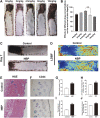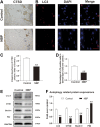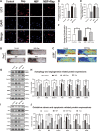Butylphthalide Inhibits Autophagy and Promotes Multiterritory Perforator Flap Survival
- PMID: 33584290
- PMCID: PMC7878674
- DOI: 10.3389/fphar.2020.612932
Butylphthalide Inhibits Autophagy and Promotes Multiterritory Perforator Flap Survival
Abstract
Multiterritory perforator flap is an important plastic surgery technique, yet its efficacy can be limited by partial necrosis at the choke Ⅱ zone. Butylphthalide (NBP) has been used for many diseases but has not been studied in the multiterritory perforator flap. With the effect of NBP, we observed increasing in capillary density, inhibition of autophagy and oxidative stress, and a reduction in apoptosis of cells, all consistent with increased flap survival. However, the protective effect of NBP on multiterritory perforator flap was lost following administration of the autophagy agonist rapamycin (Rap). Through the above results, we assumed that NBP promotes flap survival by inhibiting autophagy. Thus, this study has found a new pharmacological effect of NBP on the multiterritory perforator by inhibiting autophagy to prevent distal postoperative necrosis and exert effects on angiogenesis, oxidative stress, and apoptosis within the flap.
Keywords: Angiogenesis; Autophagy; apoptosis; butylphthalide; multiterritory perforator flap.
Copyright © 2021 Li, Chen, Luo, Zhang, Chen, Wang, Zhao, Ma, Liu, Cheng, Yang and Yan.
Conflict of interest statement
The authors declare that the research was conducted in the absence of any commercial or financial relationships that could be construed as a potential conflict of interest.
Figures







Similar articles
-
Diallyl Trisulfide Enhances the Survival of Multiterritory Perforator Skin Flaps.Front Pharmacol. 2022 Feb 15;13:809034. doi: 10.3389/fphar.2022.809034. eCollection 2022. Front Pharmacol. 2022. PMID: 35242032 Free PMC article.
-
Detrimental Effect of Sitagliptin Induced Autophagy on Multiterritory Perforator Flap Survival.Front Pharmacol. 2020 Jun 26;11:951. doi: 10.3389/fphar.2020.00951. eCollection 2020. Front Pharmacol. 2020. PMID: 32670067 Free PMC article.
-
Inhibition of autophagy after perforator flap surgery increases flap survival and angiogenesis.J Surg Res. 2018 Nov;231:83-93. doi: 10.1016/j.jss.2018.05.018. Epub 2018 Jun 12. J Surg Res. 2018. PMID: 30278973
-
Improvement of multiterritory perforator flap survival supported by a hybrid perfusion mode: A novel strategy and literature review.J Tissue Viability. 2021 May;30(2):276-281. doi: 10.1016/j.jtv.2020.12.007. Epub 2021 Jan 4. J Tissue Viability. 2021. PMID: 33422386 Review.
-
Research Advances in Vascular Remodeling in Choke Vessels of Perforator Flap: A Systematic Review.Ann Plast Surg. 2024 Aug 1;93(2):268-275. doi: 10.1097/SAP.0000000000003980. Epub 2024 May 22. Ann Plast Surg. 2024. PMID: 38775375
Cited by
-
Allicin-loaded hydrogel enhances the viability of multiterritory perforator flap.Mater Today Bio. 2025 Jun 26;33:102026. doi: 10.1016/j.mtbio.2025.102026. eCollection 2025 Aug. Mater Today Bio. 2025. PMID: 40677406 Free PMC article.
-
Diallyl Trisulfide Enhances the Survival of Multiterritory Perforator Skin Flaps.Front Pharmacol. 2022 Feb 15;13:809034. doi: 10.3389/fphar.2022.809034. eCollection 2022. Front Pharmacol. 2022. PMID: 35242032 Free PMC article.
-
Quercetin activates autophagy in the distal ischemic area of random skin flaps through Beclin1 to enhance the adaptability to energy deficiency.Heliyon. 2024 Sep 29;10(20):e38181. doi: 10.1016/j.heliyon.2024.e38181. eCollection 2024 Oct 30. Heliyon. 2024. PMID: 39497976 Free PMC article.
-
Tissue-Protective Mechanisms of Bioactive Phytochemicals in Flap Surgery.Front Pharmacol. 2022 Apr 25;13:864351. doi: 10.3389/fphar.2022.864351. eCollection 2022. Front Pharmacol. 2022. PMID: 35548348 Free PMC article. Review.
References
LinkOut - more resources
Full Text Sources
Other Literature Sources

